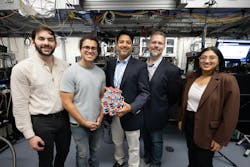Belden bolsters its quantum network position with Chicago Quantum Exchange pact
Key Highlights
- Belden's partnership with CQE connects it to leading quantum research, startups, and major tech institutions, fostering innovation in quantum-safe networking solutions.
- The collaboration aims to develop quantum-ready encryption and connectivity products to secure critical infrastructure like power plants and broadband networks against future quantum threats.
- Belden is working to bridge the traditional divide between IT and operational technology, enabling real-time data analysis and remote monitoring through sensor integration and cloud connectivity.
- The company is actively involved in adopting NIST's post-quantum cryptography standards, updating firmware and encryption methods to ensure security in a quantum-enabled future.
- Belden's expertise in fiber optics and coaxial cabling positions it to support the scaling of quantum hardware and enhance cyber security across various sectors.
Belden has entered a partnership with the Chicago Quantum Exchange (CQE), a hub for quantum science and engineering, in a move that gives it a greater foothold in the quantum-safe networking solutions market.
The CQE affiliation connects Belden to quantum research, startup ecosystems, and collaboration opportunities with major technology companies, national laboratories and academic institutions.
Gaurav Dhamija, senior director of technology and strategy for Belden, which recently toured quantum-related companies and others in Germany, said the company has been trying to advance technologies through partnerships with various entities.
“Being part of the technology team, we look at the impact of future technologies on our installed base in the future,” he said. “This is why we decided to get in touch with various quantum exchanges around the world and advance those technologies by collaborating with startups, academia, and large conglomerates, as well as drive initiatives internally at Belden in terms of how we develop a strategy to get investments and educate others.”
CQE’s collaboration drive
Like other emerging quantum hubs, CQE’s mission is centered around advancing quantum technology through a broader community of partners.
In collaboration with major universities, national labs, and industry partners, CQE is advancing the science and engineering of quantum information, preparing the quantum workforce, and driving the quantum economy.
It is based at the University of Chicago and anchored by the US Department of Energy’s Argonne National Laboratory and Fermi National Accelerator Laboratory, the University of Illinois Urbana-Champaign, the University of Wisconsin–Madison, Northwestern University, and Purdue University, and includes more than 50 corporate, international, nonprofit, and regional partners.
The CQE community includes 210+ scientists and engineers across seven member institutions.
Belden’s affiliation with the CQE came about during its research with key universities like Harvard, Stanford and ETH Zurich about next-generation technology. It started to talk to quantum hubs in key U.S. and international markets.
“As we tried to explore what’s in the space of quantum, we came across these quantum hubs that were located in Chicago, Amsterdam and Chattanooga,” Dhamija said. “We started connecting with CQE’s CEO, Kate Timmerman, to understand what quantum is and explain our problem that our products are installed in critical infrastructure like nuclear power plants, power distribution hubs, and broadband networks.”
He added that the company was also being asked by its customers “what we were doing in terms of readiness for the quantum era, so they recommended the problems and challenges they were tackling with industry experts and broader industries.”
A rising opportunity
Experts who follow Quantum computing note that the concept is approaching commercial reality. Further, these experts predict that "Q-Day" – when quantum computers can break certain encryption modalities – could become a reality in 2029.
The National Institute of Standards and Technology (NIST) finalized post-quantum cryptography standards in 2024 and recommends adoption by 2030.
This creates a need for quantum-ready networking infrastructure, and Belden is positioning itself to drive the industry's transition to quantum-secure communications.
Through this partnership with CQE, Belden will be able to get access to more ongoing research and resources related to quantum and the technology park in Chicago that will include companies like IBM and others.
Quantum technologies have various computing aspects. The computing aspect will create qubits. Once qubits are created, the teleport stage will do the necessary calculations.
Belden, which is on the communication side, would look to support quantum with its connectivity, fiber cabling, security, and routers and switches that get used in critical infrastructure. “We want to strengthen some of our encryption and have it quantum-ready,” Dhamija said. “Those are some of the areas we are doing more in-depth research and advancements with quantum exchanges and academia.”
Breaking the OT and IT divide
Another key opportunity that Belden could also assist its customers with is the integration of IT and operational technology (OT).
OT is the hardware, software, and firmware used to detect, monitor, and control physical processes and devices within industrial, energy, transportation, and manufacturing sectors, such as sensors, industrial control systems, and robotic systems. These systems are focused on the real-time operation of physical processes for safety and efficiency, versus data management for business purposes.
Timothy Waters, architecture and technology in the technology office of the CTO for Belden, said it needs to help its customers break down the barriers that have long existed between IT and OT.
“Historically, OT and IT have been bifurcated,” he said. “They have been on an island and don’t talk to each other, and that’s a point we need to educate our customers and say that’s the past, and we need to get IT and OT to work more closely together.”
A key element to make OT and IT connected is sensors. These sensors could connect to the cloud by collecting data from sensors, transmitting it via a network, and storing and analyzing it on a cloud platform to enable remote monitoring, centralized data management, real-time alerts, and advanced data analytics.
“We can help our customers take advantage of quantum and help bridge that gap,” Waters said. “With AI, you can take sensor information in manufacturing and put it into the cloud to analyze it.”
Security pain points
Encryption and security remain Belden’s key pain points in working to develop quantum solutions.
This comes on the heels of NIST's release new cybersecurity and encryption methodology, which is a set of standards for Post-Quantum Cryptography (PQC). These are algorithms designed to protect information from both current and future quantum computer threats.
The core of this methodology is the standardization of algorithms, with ML-KEM (general encryption) and ML-DSA (digital signatures) as the primary standards, and SLH-DSA for signatures, along with a backup algorithm, HQC, to ensure continued protection.
“As our hardware is installed in large installations such as airports and oil and gas refineries, we need to make sure our firmware is correctly encrypted for a post-quantum era,” Dhamija said. “We need to update now that this new NIST standard has launched three specifications for security and encryption methodology.”
However, Belden is finding that there is an opportunity for enhanced cyber safe connectivity based on fiber types as well as dilution refrigerators, where there’s a lot of coax that’s used to control the qubits.
“With Belden historically being a broadcast and AV company with coax products, we are discovering these opportunities where we can play a larger role in helping scale up hardware that’s either being developed or is in academia, trying to become more mature,” Dhamija said.
For related articles, visit the Business Topic Center.
For more information on high-speed transmission systems and suppliers, visit the Lightwave Buyer’s Guide.
To stay abreast of fiber network deployments, subscribe to Lightwave’s Service Providers and Datacom/Data Center newsletters.
NSF's $4M grant furthers universities' quantum efforts
The University of Chicago and its university partners recently received $4 million National Science Foundation (NSF) grant to design next-generation quantum computers for broad scientific and educational access. Duke, Tufts, North Carolina State, and North Carolina Agricultural and Technical State University. In all, the group has been awarded $4 million to begin actively designing a quantum supercomputer. As it moves into its second phase, the Quantum Advantage-Class Trapped Ion System (QACTI) project aims to build two quantum computing systems: a 60-qubit “proof of concept” machine anticipated by 2029, and a 256-qubit ion trap computer by 2033. These targets represent advancements to address scientific problems, from climate modeling to drug discovery, that project participants say “are extremely challenging or even out of reach for conventional computers.”
About the Author
Sean Buckley
Sean is responsible for establishing and executing the editorial strategy of Lightwave across its website, email newsletters, events, and other information products.



